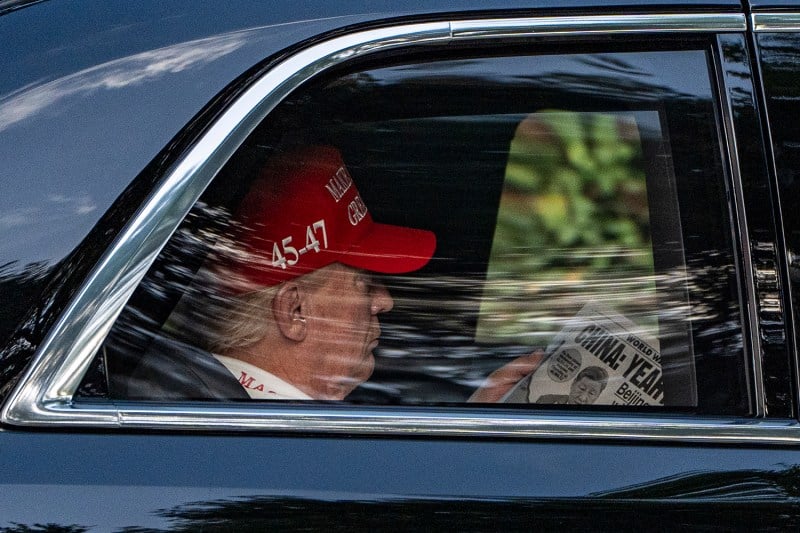U.S. Delegation Visits Greenland Amid Trump Pressure Campaign

U.S. Delegation Visits Greenland Amid Trump Pressure Campaign
Vice President J.D. Vance is the highest-ranking U.S. official to ever travel to the island.
U.S. President Donald Trump’s yearslong obsession with acquiring Greenland sparked fresh and intense backlash this week as he sent a high-profile delegation of top U.S. officials to the island—even as Greenland made clear they weren’t welcome.
After days of heightened tensions between Washington and Greenland, Vice President J.D. Vance, second lady Usha Vance, National Security Advisor Mike Waltz, Energy Secretary Chris Wright, and Republican Sen. Mike Lee touched down on the island on Friday to visit the only U.S. military base there, known as Pituffik Space Base.
U.S. President Donald Trump’s yearslong obsession with acquiring Greenland sparked fresh and intense backlash this week as he sent a high-profile delegation of top U.S. officials to the island—even as Greenland made clear they weren’t welcome.
After days of heightened tensions between Washington and Greenland, Vice President J.D. Vance, second lady Usha Vance, National Security Advisor Mike Waltz, Energy Secretary Chris Wright, and Republican Sen. Mike Lee touched down on the island on Friday to visit the only U.S. military base there, known as Pituffik Space Base.
“It’s a very high-level visit,” said Rebecca Pincus, the director of the Polar Institute at the Wilson Center. “That’s an indication that Greenland is up on the policy agenda.”
But no matter how eager Trump is to acquire Greenland, its political leaders have repeatedly insisted that the island—a semiautonomous territory of Denmark—is not for sale. That friction took center stage this week as Greenlanders balked at news of the trip, with the island’s outgoing prime minister, Mute Bourup Egede, saying that the fact that Waltz is part of the delegation proves the trip is not a “harmless visit by a politician’s wife.”
“Because what is the security advisor doing in Greenland? The only purpose is to show a demonstration of power to us, and the signal is not to be misunderstood,” Egede said in an interview with Greenlandic newspaper Sermitsiaq.
Ultimately, Friday’s itinerary is a dramatically scaled-back version of the White House’s initial plan, reflecting the island’s fierce pushback against the Trump administration’s increasingly aggressive bid to take the strategically situated and mineral-rich territory.
At first, Vice President Vance was not included in the U.S. delegation, which was slated to “visit historic sites” and “learn about Greenlandic heritage,” including attending Greenland’s national dogsled race. Then after Vance announced that he would also join the trip—an announcement that sparked opposition and made him the highest-ranking U.S. official to ever travel to the island—U.S. officials confirmed on Wednesday an itinerary change that would shorten the three-day trip to a one-day visit to only Pituffik.
The move was welcomed by Danish Foreign Minister Lars Lokke Rasmussen, who suggested that it was a sign that Washington was “de-escalating.”
“I actually think it is very positive that the Americans are canceling their visit to the Greenlandic community,” he told Danish broadcaster DR. “Then they will instead make a visit to their own base, Pituffik, and we have nothing against that.”
Yet, even with this shift in plans, Trump only appears to be ramping up his rhetorical pressure campaign against the island.
“We’ll go as far as we have to go. We need Greenland,” Trump told reporters in the Oval Office this week. “We’ll see what happens. But if we don’t have Greenland, we can’t have great international security.”
And it’s not just Greenland and Denmark that are taking the U.S. president’s comments seriously. On Thursday, Russian President Vladimir Putin said it would be a “profound mistake” to treat Trump’s Greenland threats as “preposterous talk.”
“The United States has serious plans regarding Greenland,” he said. “These plans have long historical roots, as I have just mentioned, and it is obvious that the United States will continue to consistently advance its geostrategic, military-political, and economic interests in the Arctic.”
Indeed, Trump’s is not the first U.S. administration to eye Greenland. The island has been on U.S. officials’ minds for its strategic location in the Arctic and natural resources at least as far back as the 1860s, though no one has taken as confrontational an approach to seizing the island against its will. Trump has previously refused to rule out resorting to military force to acquire Greenland.
“There’s an underlying truth to why Greenland [and] the Arctic are becoming more important—because the ice is melting, there are resources there,” said Malte Humpert, the founder of the Arctic Institute. “A region that was previously inaccessible is now becoming the playground of great-power politics, so to speak.”
Much of the U.S. interest in Greenland’s natural resources has revolved around critical minerals and rare earths, which have featured heavily in Trump’s chaotic foreign-policy moves in his first few months in office.
U.S. lawmakers in particular have been fixated on Greenland’s potential for rare earths—a set of 17 elements that are not actually that rare but underpin technology from Lockheed Martin’s F-35 fighter jets to wind turbines. China commands the processing and refining supply chains for many of the world’s critical minerals, and especially rare earths, in a dominance that has alarmed Washington and sparked a race to diversify away from Beijing’s grip.
“Greenland sits atop vast reserves of rare-earth elements,” Republican Sen. Ted Cruz said in February. “If the U.S. were to gain access to Greenland’s resources, it could significantly reduce our dependence on foreign suppliers, particularly China, which currently operates a virtual monopoly on the rare-earth market.”
But tapping Greenland’s natural resources won’t be so easy, even if the Trump administration and the island did strike some kind of agreement. While Greenland has reserves of rare earths, they are smaller than those in China, Brazil, Vietnam, India, Australia, and even the United States, according to Bloomberg.
Greenland’s location in the Arctic would also complicate any efforts to mine, which is already an expensive and lengthy process, and it’s unclear if the economics of such operations would pay off.
“It’s a decadal-long process to create a viable mining sector anywhere, and Greenland, of course, has the added difficulty that it’s Arctic,” which makes mining more challenging, said Morgan Bazilian, the director of the Payne Institute at the Colorado School of Mines.
Mining is just one piece of the puzzle, too; engineering new supply chains requires a whole host of refining and processing capabilities. “Even if there is mining, then again, the processing question comes into play,” Bazilian said.
In the midst of Trump’s threats, Greenlandic lawmakers on Thursday agreed to form a new coalition government that will become formalized with an agreement on Friday. The island on Friday also swore in its new center-right prime minister, Jens-Frederik Nielsen, who called for political unity.
“At a time when we as a people are under pressure, we must stand together,” Nielsen said.
This post is part of FP’s ongoing coverage of the Trump administration. Follow along here.
Christina Lu is an energy and environment reporter at Foreign Policy. X: @christinafei
More from Foreign Policy
-

Zelensky stands before four Ukrainian flags; cameras are pointed at him. It’s Time for Ukraine to Accept an Ugly Peace
Seven things for Zelensky to keep in mind as cease-fire negotiations start.
-

German soldiers unload the U.S.-made MIM-104 Patriot surface-to-air missile system in Jasionka, Poland. The Latest Russian Missile Is Bad News for NATO
Oreshnik is a different beast from its predecessors.
-

French Emperor Napoleon Bonaparte leads the final assault by the Imperial Guard before his defeat at the Battle of Waterloo in what is today Belgium, on June 18, 1815. The Cost of Ignoring Geopolitics
Like Napoleon and the Ming dynasty, Europe is paying the price for strategic blindness.










Join the Conversation
Commenting on this and other recent articles is just one benefit of a Foreign Policy subscription.
Already a subscriber?
.
Subscribe
Subscribe
View Comments
Join the Conversation
Join the conversation on this and other recent Foreign Policy articles when you subscribe now.
Subscribe
Subscribe
Not your account?
View Comments
Join the Conversation
Please follow our comment guidelines, stay on topic, and be civil, courteous, and respectful of others’ beliefs.
Change your username |
Log out
Change your username:
CANCEL
Confirm your username to get started.
The default username below has been generated using the first name and last initial on your FP subscriber account. Usernames may be updated at any time and must not contain inappropriate or offensive language.